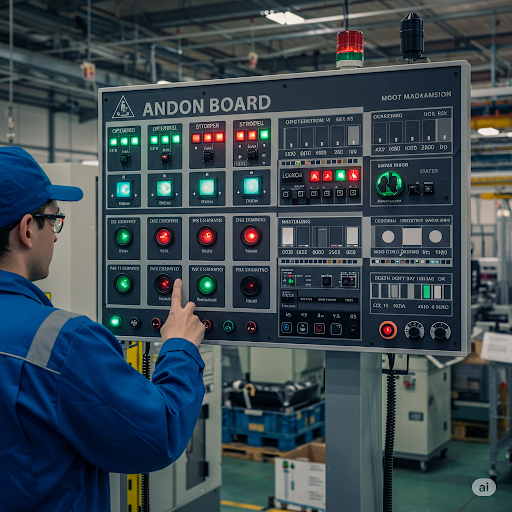The Toyota Production System (TPS) is a production management system developed by Toyota Motor Corporation in Japan during the second half of the 20th century. Shaped in response to Japan’s economic conditions following World War II, this system was structured with the goals of eliminating waste, simplifying processes, and increasing productivity—differentiating it from Western mass production systems. TPS was shaped through the contributions of Taiichi Ohno and Shigeo Shingo, and over time, it has been implemented across various industries.

A Production Line Implementing the Toyota Production System (Generated by Artificial Intelligence)
Philosophical Foundations and Core Principles
The Toyota Production System is based on two fundamental principles: “Just-In-Time” and “Jidoka” (quality assurance through automatic stoppage). Just-In-Time ensures that only the required products are produced, at the required time and in the required quantity. This system aims to reduce overproduction and inventory costs. Jidoka allows the production line to stop automatically when an error or problem is detected, enabling the issue to be addressed at its source.
TPS aims to eliminate three types of problems: “muda” (waste), “mura” (unevenness), and “muri” (overburden). These elements are used to identify inefficiencies in production processes. For example, unnecessary transportation, waiting, or overproduction fall under the category of “muda,” and reducing them is among the system’s core objectives. The system is supported by continuous improvement activities (kaizen). Processes are regularly reviewed, and improvement suggestions are evaluated. These efforts are carried out with the participation of all employees working on the production line.

Toyota Factory Assembly Line (Generated by Artificial Intelligence)
The Toyota Production System is implemented at the operational level through various methods. These include the Kanban system, Poka-Yoke (error-prevention systems), Andon boards (visual alert systems), cellular production layouts, standardized work definitions, and the assignment of multifunctional workers.
The Kanban system ensures production occurs only based on demand. Each production station operates according to signals received from the preceding station. This method prevents overproduction and the accumulation of inventory.
Poka-Yoke systems involve low-cost technical measures designed to prevent errors before they occur. These systems contribute to ensuring quality assurance within the production process.

Workers Operating with the Kanban System (Generated by Artificial Intelligence)
Andon boards enable the immediate detection and visualization of problems on the production line. Operators report disruptions in the system by pulling the Andon cord or activating warning signals, which stop production and allow for quick resolution of the issue.
Within the TPS framework, employees are often cross-trained and skilled in multiple tasks. Supported by team leadership and job rotation practices, this structure increases flexibility on the production line.

Andon Board (Generated by Artificial Intelligence)
Global Impact and Areas of Application
The Toyota Production System (TPS) was initially implemented in Toyota’s automotive assembly lines. Over time, this system has been adapted and applied across various manufacturing and service sectors. In the 1990s, international research conducted by the Massachusetts Institute of Technology (MIT) analyzed the system’s performance and linked it to the concept of lean production.
TPS has also been applied in fields such as healthcare, construction, software development, and logistics. For example, in some hospitals, operating room preparation processes have been restructured using Kanban-like systems. The applicability of the system depends not only on technical tools but also on internal organizational discipline and structures. Some management tools used within TPS include “genchi genbutsu” (go and see for yourself) and “hoshin kanri” (policy deployment). These tools facilitate the use of direct observation-based information in decision-making processes and the dissemination of strategic objectives throughout the entire organization.


